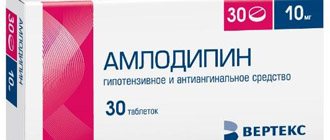Vero-Amlodipine
Amlodipine can be safely used for the treatment of arterial hypertension together with thiazide diuretics, alpha-blockers, beta-blockers or ACE inhibitors. In patients with stable angina, amlodipine can be combined with other antianginal agents, for example, long-acting and short-acting nitrates, beta-blockers.
Unlike other BMCCs, no clinically significant interaction of amlodipine (III generation BMCCs) was found when used together with non-steroidal anti-inflammatory drugs (NSAIDs), including indomethacin.
It is possible to enhance the antianginal and hypotensive effect of BMCC when used together with thiazide and loop diuretics, ACE inhibitors, beta-blockers and nitrates, as well as enhance their hypotensive effect when used together with alpha1-blockers, antipsychotics.
Although negative inotropic effects have generally not been observed in amlodipine studies, some CBMCs may enhance the negative inotropic effects of antiarrhythmic drugs that cause QT prolongation (eg, amiodarone and quinidine).
Amlodipine can also be safely used concomitantly with antibiotics and oral hypoglycemic agents.
A single dose of 100 mg of sildenafil in patients with essential hypertension does not affect the pharmacokinetic parameters of amlodipine.
Repeated use of amlodipine at a dose of 10 mg and atorvastatin at a dose of 80 mg is not accompanied by a significant change in the pharmacokinetics of atorvastatin.
Simvastatin: simultaneous repeated use of amlodipine at a dose of 10 mg and simvastatin at a dose of 80 mg leads to an increase in simvastatin exposure by 77%. In such cases, the dose of simvastatin should be limited to 20 mg.
Ethanol (drinks containing alcohol): amlodipine with single and repeated use in a dose of 10 mg does not affect the pharmacokinetics of ethanol.
Antiviral agents (ritonavir): increases plasma concentrations of BMCC, including amlodipine.
Neuroleptics and isoflurane: enhancing the hypotensive effect of dihydropyridine derivatives.
Calcium supplements can reduce the effect of BMCC.
When BMCC is used together with lithium preparations (no data are available for amlodipine), their neurotoxicity (nausea, vomiting, diarrhea, ataxia, tremor, tinnitus) may increase.
Studies of the simultaneous use of amlodipine and cyclosporine in healthy volunteers and all groups of patients, with the exception of patients after kidney transplantation, have not been conducted. Various studies of the interaction of amlodipine with cyclosporine in patients after kidney transplantation show that the use of this combination may not lead to any effect, or increase the minimum concentration of cyclosporine to varying degrees, up to 40%. These data should be taken into account and cyclosporine concentrations should be monitored in this group of patients when cyclosporine and amlodipine are co-administered.
Does not affect the serum concentration of digoxin and its renal clearance.
Does not significantly affect the effect of warfarin (prothrombin time). Cimetidine does not affect the pharmacokinetics of amlodipine.
In in
vitro
, amlodipine does not affect the plasma protein binding of digoxin, phenytoin, warfarin and indomethacin.
Grapefruit juice: simultaneous administration of 240 ml of grapefruit juice and 10 mg of amlodipine orally is not accompanied by a significant change in the pharmacokinetics of amlodipine. However, it is not recommended to use grapefruit juice and amlodipine at the same time, since genetic polymorphism of the CYP3A4 isoenzyme may increase the bioavailability of amlodipine and, as a result, enhance the hypotensive effect.
Aluminum- or magnesium-containing antacids: their single dose does not have a significant effect on the pharmacokinetics of amlodipine.
Inhibitors of the CYP3A4 isoenzyme: with simultaneous use of diltiazem at a dose of 180 mg and amlodipine at a dose of 5 mg in patients from 69 to 87 years of age with arterial hypertension, there is an increase in systemic exposure of amlodipine by 57%. Concomitant use of amlodipine and erythromycin in healthy volunteers (18 to 43 years of age) does not lead to significant changes in amlodipine exposure (increase in area under the concentration-time curve (AUC) by 22%). Although the clinical significance of these effects is unclear, they may be more pronounced in older patients.
Potent inhibitors of the CYP3A4 isoenzyme (for example, ketoconazole, itraconazole) may increase the plasma concentration of amlodipine to a greater extent than diltiazem. Amlodipine and inhibitors of the CYP3A4 isoenzyme should be used with caution.
Clarithromycin: CYP3A4 inhibitor. Patients taking clarithromycin and amlodipine at the same time have an increased risk of low blood pressure. Patients taking this combination are advised to be under close medical supervision.
Inducers of the CYP3A4 isoenzyme: there is no data on the effect of inducers of the CYP3A4 isoenzyme on the pharmacokinetics of amlodipine. Blood pressure should be carefully monitored during concomitant use of amlodipine and inducers of the CYP3A4 isoenzyme.
Tacrolimus: When used concomitantly with amlodipine, there is a risk of increasing the concentration of tacrolimus in the blood plasma. To avoid toxicity of tacrolimus when used concomitantly with amlodipine, the concentration of tacrolimus in the blood plasma of patients should be monitored and the dose of tacrolimus should be adjusted if necessary.
mTOR inhibitors (mammalian Target of Rapamycin - mechanistic target of rapamycin in mammalian cells): mTOR inhibitors (for example, temsirolimus, sirolimus, everolimus) are substrates of the CYP3A4 isoenzyme. Since amlodipine is a weak inhibitor of the CYP3A4 isoenzyme, co-administration of amlodipine with mTOR inhibitors may increase their exposure.
Vero-Amlodipine, 5 mg, tablets, 30 pcs.
It is possible to enhance the antianginal and antihypertensive effect of slow calcium channel blockers when used together with thiazide and loop diuretics, ACE inhibitors, beta-blockers and nitrates, as well as enhance their antihypertensive effect when used together with alpha1-blockers, antipsychotics.
Although negative inotropic effects have not generally been observed in amlodipine studies, some calcium channel blockers may enhance the negative inotropic effects of antiarrhythmic drugs that cause QT prolongation (eg, amiodarone and quinidine).
Simultaneous repeated use of amlodipine at a dose of 10 mg and simvastatin at a dose of 80 mg leads to an increase in the bioavailability of simvastatin by 77%. In such cases, the dose of simvastatin should be limited to 20 mg.
Antiviral drugs (for example, ritonavir) increase plasma concentrations of slow calcium channel blockers, incl. amlodipine.
With the simultaneous use of sympathomimetics and estrogens, the antihypertensive effect may be reduced due to sodium retention in the body.
Neuroleptics and isoflurane enhance the antihypertensive effect of dihydropyridine derivatives. With the simultaneous use of inhalation anesthesia, the hypotensive effect may be enhanced.
With simultaneous use of amiodarone, the antihypertensive effect may be enhanced.
With simultaneous use of lithium carbonate, manifestations of neurotoxicity (including nausea, vomiting, diarrhea, ataxia, tremors and/or tinnitus) are possible.
With simultaneous use, orlistat reduces the antihypertensive effect of amlodipine, which can lead to a significant increase in blood pressure and the development of a hypertensive crisis.
With the simultaneous use of indomethacin and other NSAIDs, the antihypertensive effect of amlodipine may be reduced due to inhibition of prostaglandin synthesis in the kidneys and fluid retention under the influence of NSAIDs.
With simultaneous use of quinidine, the antihypertensive effect may be enhanced.
Calcium supplements may reduce the effect of slow calcium channel blockers.
With simultaneous use of diltiazem (CYP3A4 isoenzyme inhibitor) at a dose of 180 mg and amlodipine at a dose of 5 mg in elderly patients (69 to 87 years) with arterial hypertension, an increase in the bioavailability of amlodipine by 57% was observed. Concomitant use of amlodipine and erythromycin in healthy volunteers (18 to 43 years of age) does not lead to significant changes in amlodipine exposure (22% increase in AUC). Although the clinical significance of these effects is unclear, they may be more pronounced in older patients. Potent inhibitors of the CYP3A4 isoenzyme (for example, ketoconazole, itraconazole) may increase the plasma concentration of amlodipine to a greater extent than diltiazem. Amlodipine and inhibitors of the CYP3A4 isoenzyme should be used with caution.
There are no data on the effect of inducers of the CYP3A4 isoenzyme on the pharmacokinetics of amlodipine. Blood pressure should be carefully monitored while using amlodipine and inducers of the CYP3A4 isoenzyme.
Vero-Amlodipine, 30 pcs., 10 mg, tablets
A blocker of “slow” calcium channels (SCBC), a dihydropyridine derivative, blocks “slow” calcium channels, reduces the transmembrane transition of calcium ions into the cell (more into vascular smooth muscle cells than into cardiomyocytes).
Has antianginal and hypotensive effects.
Reduces the severity of myocardial ischemia. The antianginal effect is due to the expansion of the coronary and peripheral arteries and arterioles: by expanding the peripheral arterioles, it reduces the total peripheral vascular resistance (TPVR), reduces the afterload on the heart, thereby reducing the myocardial oxygen demand; expanding the coronary arteries and arterioles in unchanged and ischemic areas of the myocardium, increases the supply of oxygen to the myocardium (especially with Prinzmetal vasospastic angina), and prevents the development of spasm of the coronary arteries (including those caused by smoking). In patients with angina pectoris, a single daily dose of amlodipine increases the time of physical activity, delays the development of an attack of angina and “ischemic” depression of the ST segment during physical activity, reduces the frequency of angina attacks and nitroglycerin consumption.
It has a long-term dose-dependent hypotensive effect. The hypotensive effect is due to a direct vasodilating effect on vascular smooth muscle. For arterial hypertension, a single dose of amlodipine provides a clinically significant decrease in blood pressure (BP) over 24 hours (in the patient’s “lying” and “standing” position).
Does not cause a sharp decrease in blood pressure, left ventricular ejection fraction and a decrease in exercise tolerance. Reduces the degree of left ventricular myocardial hypertrophy and has a cardioprotective effect in coronary heart disease (CHD).
It has no effect on myocardial contractility and conductivity, does not cause a reflex increase in heart rate, inhibits platelet aggregation, increases the glomerular filtration rate, and has a weak natriuretic effect. In diabetic nephropathy, it does not increase the severity of microalbuminuria.
In patients with diseases of the cardiovascular system (including coronary atherosclerosis with damage to one vessel and up to stenosis of 3 or more arteries, atherosclerosis of the carotid arteries), who have had myocardial infarction, percutaneous transluminal angioplasty (TLP) of the coronary arteries or patients with angina pectoris, the use of amlodipine prevents the development of thickening of the intima-media of the carotid arteries, reduces mortality from myocardial infarction, stroke, TLP, coronary artery bypass grafting; leads to a decrease in the number of hospitalizations for unstable angina and progression of chronic heart failure (CHF); reduces the frequency of interventions aimed at restoring coronary blood flow.
Does not increase the risk of death or the development of complications and deaths in patients with CHF (III-IV functional class according to the NYHA classification) during therapy with digoxin, diuretics and angiotensin-converting enzyme (ACE) inhibitors. In patients with CHF (III-IV functional class according to the NYHA classification) of non-ischemic etiology, when using amlodipine, there is a risk of pulmonary edema.
Does not have an adverse effect on metabolism and plasma lipid concentrations.
The onset of effect is 2-4 hours; duration - 24 hours.

